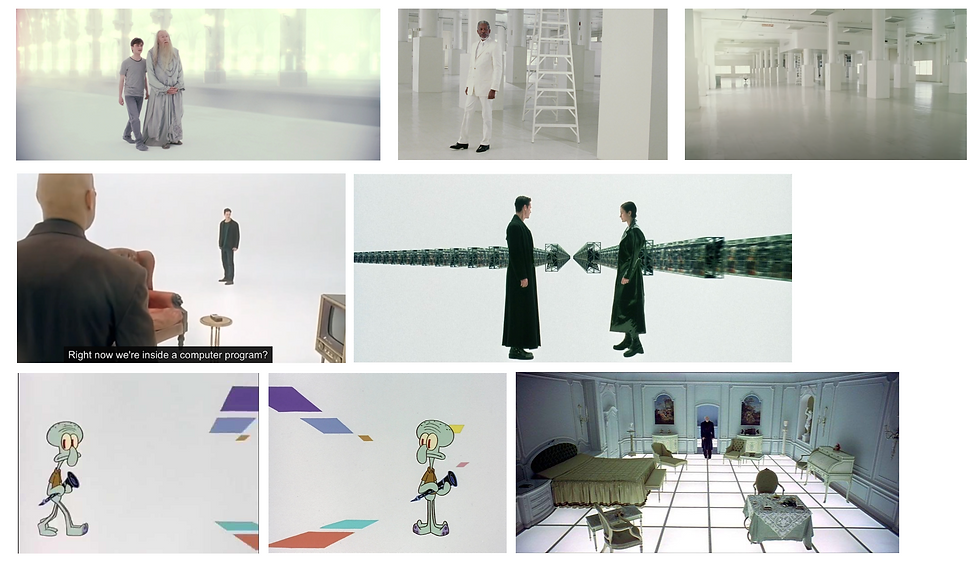How we co-create our live show concepts
- joostdeboo
- Dec 22, 2023
- 4 min read
Updated: Jan 30, 2024
In order to create the most useful emerging tech toolbox, the Open Culture Tech team works closely together with 12 selected artists. Every artist has the unique opportunity to develop a live show for which we build unique technology. Ultimately, we publish all this technology toolbox on our website so that every artist in the Netherlands has the same opportunity to experiment with the tools. In this article, we'll tell you all about our process and progress.

Moodboard for the Smitty live show. Sources: Harry Potter, Bruce Almighty, The Matrix, Spongebob, 2001: Space Odyssey
The process of designing the creative concepts for the 12 live shows is delicate. On the one hand we have to deal with the ever growing range of new technologies and possibilities, and on the other hand we need to make sure that the artist is strengthened by this technology and remains the centerpiece of the performance.
It is important to note that Open Culture Tech does not research whether the latest AI, AR or Avatar technology works for live artists. There are many companies already proving that, such as WaveXR. Instead, Open Culture Tech is about whether these technologies can also work for emerging artists, who don’t have the means to work with complex or expensive software. In addition, we also want to ensure that the artist's autonomy is always guaranteed and that the technology is an addition to this rather than a replacement.
The development of our 12 shows and 12 tools is done according to our own Open Culture Tech method, which consists of a number of steps. The first step is to come up with an overarching concept together with the individual artists. Based on this concept, we decide if and how we need AI, AR or Avatar technology. The second step is to create and test first prototypes with our tech partners. The third step is to create a final prototype – based on the feedback and input from step two – that can be used on stage during the actual show.
To provide more insights in this creative process, we will explain how the concept building process works by going over two examples that we are currently working on.

Smitty
Smitty is a rapper and producer who just released his new EP. In his music, he often shows two sides of himself – that often contradict each other. Tough and vulnerable. Adult and child. Hope and sorrow. During his live show, he wants to emphasize this duality in both his music and his visuals.
We have been going over different possibilities to emphasize this overall concept. To display the duality of Smitty’s mind, we can create multiple avatars representing different versions of the artist. We can use AI or 3D technology to create images of Smitty in different phases of his life, maybe as a child or as an old man. We can also use animation to create moving images and let the avatars interact with Smitty. He could literally talk with different versions of himself.
The weight of Smitty’s music is in his lyrics. To emphasize this, we want to emphasize the most important words by leveraging new technology. For example, mobile AR could be used to add a virtual layer to the show and let the words flow in 3D.
Another important starting point was the use of color and space. Smitty would love to have a stage in the middle of a white venue – so that everyone can stand around him. Perhaps an art gallery or empty warehouse with white walls and video projections. This white space is inspired by the “void rooms” often used in Hollywood productions such as The Matrix or even Spongebob. It transports the audience into Smitty’s mind, a canvas in which we are all stuck together.

Sophie Jurrjens
Sophie Jurrjens is a person of many talents. She is a pianist, composer and producer and also works as a DJ. In the past years, she has developed an app called Off-Track with music walking tours throughout Amsterdam, for which all music was created by herself.
By adding music to a walking route, going for a walk is transformed into an experience.
The walking tours evolved from the idea that “by adding music to a walking route, going for a walk is transformed into an experience”. Sophie wants to translate this idea into a live DJ set, where visitors start with a walking tour in Amsterdam North and finish at a fixed location where she is performing as a live DJ.
The keyword in our creative process is “grandiosity”. How can we add interactive or visual elements to the walking tour to create a grandiose atmosphere? The answer turned out to be mobile augmented reality. By using mobile AR, visitors can experience virtual objects or that appear in 3D during the walking tour. These virtual objects can return during the final live show.
The music tour starts at the NDSM Werf in Amsterdam North and should finish at a venue located alongside the IJ canal. In this way, we can use the canal as a backdrop for the mobile AR filter and create large grandiose 3D objects. In addition, we will add light tubes or aesthetic lamps to the physical stage design. The shapes of the lamps will also be translated into 3D objects to bring together the virtual and physical world.
Our next step is to create and test the first basic prototypes together with our tech partners Reblika and Superposition and plan the actual live shows. Keep an eye on our website for the first results and exact show dates.

Comments